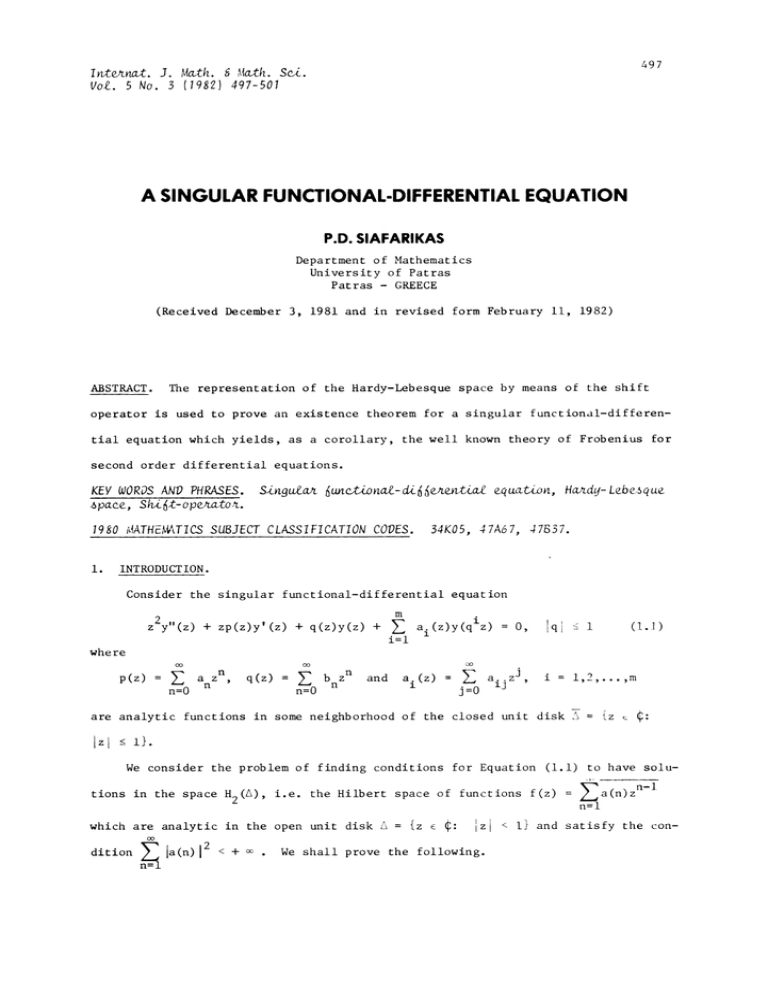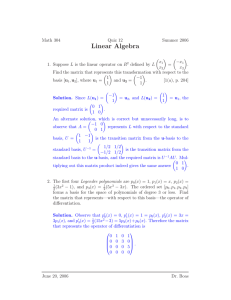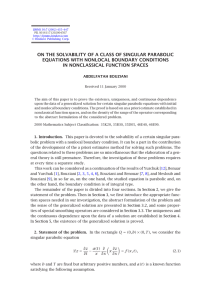A SINGULAR FUNCTIONAL-DIFFERENTIAL
advertisement

497
I nternat. J. Math. & qath. Sci.
Vol. 5 No. 3 (1982)497-501
A SINGULAR FUNCTIONAL-DIFFERENTIAL EQUATION
P.D. $1AFARIKAS
Department of Mathematics
University of Patras
GREECE
Patras
(Received December 3, 1981 and in revised form February ii, 1982)
The representation of the Hardy-Lebesque space by means of the shift
ABSTRACT.
operator is used to prove an existence theorem for a singular functional-differen-
tial equation which yields, as a corollary, the well known theory of Frobenius for
second order differential equations.
KEY WORDS AND PHRASES.
space, Shift-operor.
Singular
1980 MATHEMATICS SUBJECT CLASSIFICATION CODES.
1.
equation, Hardy-Lebesque
funnal-differenti
34K05, 47A67, 47B37.
INT RODUCT ION.
Consider the singular functional-differential equation
z
2y,, (z)
m
ai(z)y(qlz)
+ zp(z)y (z) + q(z)y(z) +
0
lql
(i ])
1
i=l
where
p(z)
n=0
anZ
n
q(z)
n= 0
b z
n
n
and
a (z)
i
aij z
=0
j
i
i,
m
{z
are analytic functions in some neighborhood of the closed unit disk A
:
We consider the problem of finding conditions for Equation (i.i) to have solu-
H2(A)
tions in the space
n-1
which are analytic in the open unit disk A
la(n)12
dition
n=l
<
+
a(n)z
i.e. the Hilbert space of functions f(z)
{z
:
zl
We shall prove the following.
<
I} and satisfy the con-
498
P.D. S IAFARIKAS
Let
THEOREM.
i) +
k(k
a0k + b 0
(1.2)
0
be the idicial equation of the unperturbed equation (i.i).
(i)
If 2k
+
a
k
i
0
_+
k2
I
n, n
1,2
then Equation (i.i) has
two linearly independent solutions of the form:
YI(Z)
where k
and k
I
2
If 2k
(ii)
k
u(z)
z
Y2(Z)
and
z
k2
u(z),
are the roots of Equation (1.2) and u(z) belongs to
+
a
0
k
i
k
I
O, i.e. k I
2
k2,
H2(A).
then Equation (i.i) has
only one solution of the form:
zku(z),
y(z)
where k is the double root of Equation (1.2) and u(z) belongs to
(ill)
If 2k
+ a0
1
6
k
k
I
n, n
2
H2(A).
1,2,..., then Equation (1.2) has
always a solution of the form:
k
y(z)
where k
z
is the greatest root of Equation
I
lu(z),
(1.2) and u(z) belongs to
H2(A).
This theorem obviously generalizes the well known Frobenius theory [i] for the
Fuchs differential equations:
z2y"(z)
+ zp(z)y’(z) + q(z)y(z)
O,
which is a particular case of Equation (i.I).
Denote an abstract separable Hilbert space over the complex field by H, the
Hardy-Lebesque space by
H2(A
an ortho-normal basis in H by
Ven en+l)
lateral shift operator on H(V:
by V.
{en}On=l,
and the uni-
We can easily see that the
following statements hold:
Every value z in the unit disk
(i)
V*en en_ I,
V*(V*:
Z zn-len
fz
to f
n # i, V*e
I
(Izl
< i) is an eigenvalue of
0), the adjoint of V.
The eigenelements
form a complete system in H, in the sense that if f is orthogonal
n=l
for every z:
z
(ii)
zl
< i then f
The mapping f(z)
(fz’f)’
O.
f
H is an isomorphism from H onto
H2(A).
499
SINGULAR FUNCTIONAL-DIFFERENTIAL EQUATION
(iii)
The diagonal operator
CO: C0en nen,
extension in H with a compact inverse B:
(fz, f)
f(z)
Be
n
1,2,..., has a self-adjolned
n
i
e
n n
n
Moreover, if
1,2,...,
then
vnf)
z nf (z)
(f
f(n)(z)
(fz’(CoV*)nf)
(1.4)
zf’(z)
(fz’(CO
(1.5)
z
(1.3)
I)f).
We shall use the proposition 1 of Reference [2].
PROOF OF THE THEOREM.
2.
zku(z),
The transformation y(z)
reduces Equation (i.I) in the following:
zu"(z)+(h0+hlZ+h2z2+... )u’ (z)+(00+01z+02z 2+...
+
where k(k- I)
ka
2
+
b
ka
01
2
I,R2
R
RlU(Z)
u(qz),
R
m
ka
3
+
0
+
b
b
as
lql
< i,
E
i=l
qika i (z)u(qiz)=0,
ho, al=hl, a2=h2, a3=h3,..,
and
(2.1)
kal+bl=O0
Following Reference [2], we define the operators
02
3
2(A)
on H
0, 2k + a 0
0
m
u (z)+
R2u(z)
2
u(q2z)
Rl(U(Z))...RmU(Z)
U(qmZ)
m
R
I
u(z)
m
Thus the operator R:
E qikai(z)u(qlz)’
Ru(z)
lql
<
I, on
i=l
H2(A)
is represented
in the space H by the operator
,
Z q ika i(V)
() i u
i=l
m
R:
where R
I
is defined on H as
solution in
H2(A)
Ru
Rlen
en,
q
n
The equation (2.1) has a
1,2,
if and only if the operator equation
[V(CoV*)2 + #I(V)CoV* + 2(V) + ]u
(2.2)
0
has a solution u in the abstract separable Hilbert space H.
Here u
Z (U’en)en’ I(V)
(2k +
a0)l
n=l
2(V)
001 + OIV +
+
hlV + h2V2
+
02 +
where the bar denotes complex conjugation.
Taking into account the relations
V2Co
v*
V(C0
Equation (2.2) can be written as
I)
and
VC
0
C
0
---V,
500
P.D. SIAFARIKAS
![C0
+ (2k +
a
B2V@i(V)]
i) I + BO(V)
0
+
V*
B
B@2(V
+
+
2
+ 3h 3 V +
O,
u
(2.3)
where
(V)
hlV
h2V2 +
+
Also, if we put 2 +
a
h V
3
I
0
3
+
and
I (V)
h
i
2h2V
# in Equation (2.3), we have
V*[I + VK]
(2.4)
0
u
where the operator
is compact.
B2(V)Co V* + B22(V)
+
gBV*
K
Relation
0 =>u
(2.6) if 6
(2.7) if
c
cel,
Now it follows that the operator (I
Relation
B2
Relation (2.4) implies that
(I + VK) u
(I + VK) u
+
+ VK)
-i
(2.5)
const.
exists.
In fact,
-<u
=>(u,el) -(Ku,V*el) O. Also,
(u,e 2)
-(u,K*e I) =>(u,e 2)(I + 6)
#-i --> (u,e 2)
0. Similarly,
(u,e 3)
-(uK*e 2) --> (u,e3) (l +
# -2
= (u,e3)
O.
0
(2.6)
0.
(2.7)
By the same way and if
# -n,
n
1,2
we find
u
n=l
(u,e)en
O.
Since also the operator VK is compact Fredholm alternative implies that the operator
(I + VK)
-i
Thus from Equation (2.5), we have
is defined every where.
(I + VK)
c
u
-I e
I
This means that
(i)
(I + VK)
If 2k
-i
+ a0
k
1
always exists.
k
I
_+ n with n
2 #
1,2
then the operator
Therefore, Equation (l.1) has two linearly independent
solutions of the form
Yl (z)
where k
I
and k
2
z kl
u(z)
and
Y2 (z)
zk2u(z)
are the roots of Equation (1.2) and u(z) belongs to
H2(A)
given by the relation
u(z)
(Uz,U)
u
z
z
n-1
n-1
e n, u-- c
(I + VK)
-1
e
1.
and is
501
SINGULAR FUNCTIONAL-DIFFERENTIAL EQUATION
(ii)
(I + VK)
If 2k
-i
+
a
0
6
1
k
k
I
0, i.e. k I
2
k2,
then the operator
Therefore, Equation (i.i) has only one solution of the
always exists.
fo rm
zku(z)
y(z)
where k is the double root of Equation (2.1) and u(z) as in (i).
(iii)
If 2k
+ a0
6
1
k
+ a0
2k + a
0
2
2k
I
k
I
n, n
2
i
n,
i
-n, n
n
1,2,..., then
i,
1,2,...,
From the above and the Relations (2.6) and (2.7), we see that Equation (i.i) has
always a solution of the form
y(z)
where k
I
z
k
u(z),
is the greatest root af Equation (1.2) and u(z) as in (i).
All the
above complete the proof of the theorem.
ACKNOWLEDGEMENTS.
I am grateful to Professor E.K. Ifantis, for suggesting the
topic of this research and for his continuous interest.
REFERENCES
I.
HILLE, E.
"Ordinary differential equation in the complex domain", Wiley-
Interscience, 19 76.
2.
An Existence theory for functional-differential equations and
functional differential systems, Jour. Diff. Equat. 29, No. i (1978),
IFANTIS, E.K.
86-104.







